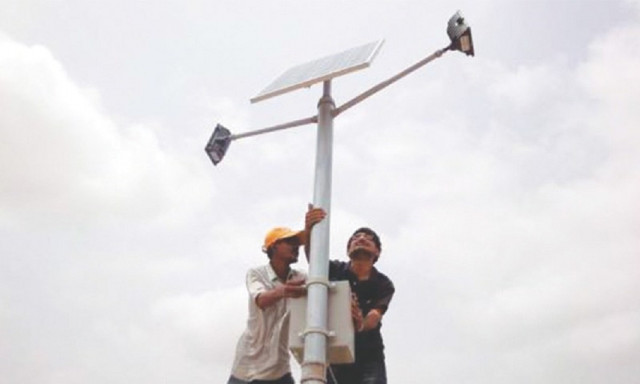Tea, haircuts and fish bones: Letting the light into Pakistan
Villagers describe amenities they can enjoy after getting solar-powered electricity installed in homes and businesses

Villages install solar panels in a village in Sindh.
PHOTO: REUTERS/ FILE
“Now I can eat fish and not worry about bones getting stuck in my throat,” Mohammad told the Thomson Reuters Foundation, describing how he enjoys a well-lit evening meal since his son, Ghulam Nabi, installed solar bulbs in his home three months ago.
For nearly a decade, chronic power shortages have hobbled Pakistan’s economy, leaving 144 million people without electricity or enduring lengthy blackouts, the World Bank says.
Regulations for solar power net metering system approved
Globally, more than one billion people, or one in seven, lacked access to electricity in 2014 and many more suffer from poor supply, which keeps them trapped in poverty, reliant on wood, candles and kerosene, experts say.
These numbers may be grim but young entrepreneurs like Saad Ahmad see this as huge growth potential in Pakistan, which generates only two-thirds of its energy needs.
“There is massive opportunity for business,” said Ahmad, 26, chief executive of solar energy supplier Nizam Bijli, which has powered 1,300 homes since it started in 2016 and hopes to reach 1 million people by 2020.
“There is room for many companies to make a difference in the lives of these communities.”
Leapfrog
While the government is investing heavily in coal-fired power plants, tapping into underground coal reserves, private investors are exploring renewable energy.
Government Girls Secondary School deprived of electricity for four years
A similar ‘off-grid revolution’ is afoot across Africa due to fast-dropping costs and plenty of sun.
Currently only four per cent of Pakistani households tap into solar power due to lack of awareness, limited supply chains and a shortage of consumer financing for relatively high up-front costs, according to the World Bank.
Nizam Bijli installs pay-as-you-go solar systems in homes and businesses, where customers pay 2,000 Pakistani rupees ($18) a month over 16 months for three bulbs, one fan and two USB slots to charge their mobile phones.
Ahmad believes this is affordable as families spend a similar amount on kerosene and charging mobile phones in nearby towns. The average income in Pakistan is about $1,450, according to World Bank data.
Ahmad is certain the only way out of Pakistan’s energy crisis is to bypass the grid and leapfrog straight into low-carbon sources like wind and solar.
“The whopping costs associated with grid extension (and) low electricity consumption by rural communities dispersed over large swathes presents a barrier to investment,” he said.
Pakistan already has one major solar park in the eastern province of Punjab, built with Chinese investment. Meanwhile, the parliament in Islamabad switched to solar energy in 2016 and sells excess energy it produces back to the grid.
Tea and Cigarettes
Allah Dino’s barber shop in Khorwah, 180 kilometres east of Pakistan’s largest city, Karachi, is connected to the grid.
But intermittent power had forced him to close by sunset. Now he has solar, his business is open until close to midnight.
“There is never an idle moment and my men now work in shifts,” Dino said.
Golen Gol could help power economy
Next door in Bhittai roadside restaurant, solar has also been good for Mohammad Azeem. It allows truckers to stop by throughout the night to drink his tea, brewed on wooden stoves.
Azeem said he plans to add more fans when it gets hot in summer to make customers more comfortable and blow away flies for the longer customers sit, the more tea they drink.
Ali Mohammad, who runs a cigarette kiosk inside the restaurant, has seen his business pick up as well.
“My shop would remain open using a torch but hardly anyone came,” he said. “Now my corner is well lit and Azeem’s customers stop by on their way out.”
Scaling up Nizam Bijli has proven challenging as Ahmad has to wait 16 months for payment for the solar kits, which means a lack of working capital to buy more stock in the interim.
Govt producing surplus electricity: Leghari
Many banks find the prospect of lending to a company whose customers live on or below the poverty line too risky, he said.
Promises by aspiring politicians do not help either, as Pakistan counts down to polls next year.
“Potential customers often say they will wait for free handouts as they know a nearby village has been given solar by some politician or other to win over their constituency,” said Ahmad. “This phenomenon is quite common near elections.”



















COMMENTS
Comments are moderated and generally will be posted if they are on-topic and not abusive.
For more information, please see our Comments FAQ